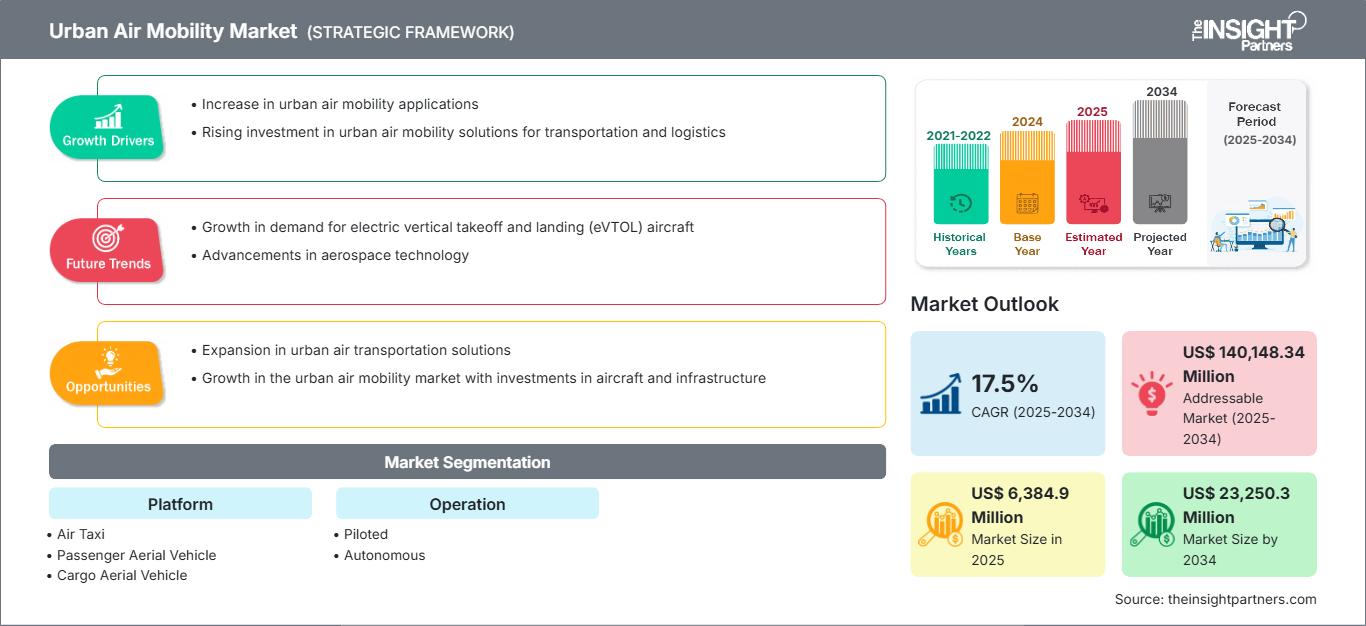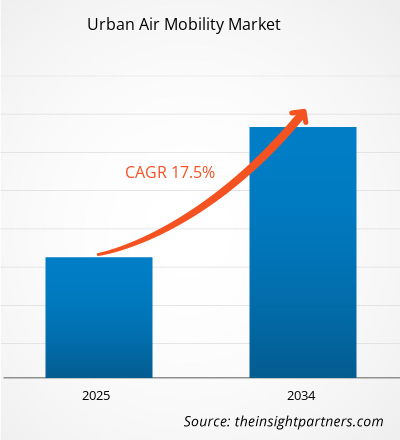预计2025年城市空中交通市场价值将达到63.849亿美元,到2034年预计将达到232.503亿美元,预计在2025年至2034年的预测期内,复合年增长率将达到17.5%。
城市空中交通客运车至少可搭载三名乘客,最多可搭载五六名乘客。在农村地区,根据要求,六名以上的乘客可以乘坐三轮客运车。城市交通拥堵加剧是推动市场增长的主要因素。随着世界城市人口的增长,交通拥堵严重影响了人们的生活质量,并对整体经济增长造成了损害。例如,根据交通分析公司INRIX的调查,美国通勤者在交通高峰时段每年大约要在路上花费41个小时。它还提到,2017 年交通拥堵给美国司机造成了约 3050 亿美元的损失,这意味着平均每个司机损失 1445 美元。此外,美国环境保护署估计,平均每辆乘用车每年排放 4.7 公吨二氧化碳。此外,随着印度和中国等发展中国家汽车拥有量的增加,车祸数量激增。根据世界卫生组织 (WHO) 的数据,每年约有 125 万人死于车祸,每天约有 3400 人死亡。这还没有计算非致命事故中数百万人的受伤。
全球城市空中交通市场按类型细分为客运和货运。根据燃料类型,城市空中交通市场细分为柴油、汽油、压缩天然气、液化石油气和电力。对电动城市空中交通的需求不断增长、人口不断增加以及对有助于缓解该地区交通拥堵的车辆的需求不断增加,推动了全球城市空中交通市场的增长。
自定义此报告以满足您的要求
您将免费获得任何报告的定制,包括本报告的部分内容,或国家级分析、Excel 数据包,以及为初创企业和大学提供超值优惠和折扣
城市空中交通市场: 战略洞察

- 获取本报告的主要市场趋势。这个免费样本将包括数据分析,从市场趋势到估计和预测。
城市空中交通市场洞察 航空与自动驾驶技术进步
您将免费获得任何报告的定制,包括本报告的部分内容,或国家级分析、Excel 数据包,以及为初创企业和大学提供超值优惠和折扣
城市空中交通市场: 战略洞察

- 获取本报告的主要市场趋势。这个免费样本将包括数据分析,从市场趋势到估计和预测。
航空技术的进步正在为大都市地区的人员和货物提供便捷高效的按需运输服务。城市空中交通 (UAM) 是一种具有重塑社会交通潜力的交通理念。它提出了经济实惠、便捷快速的城市空中交通,通过减轻现有道路交通基础设施的负担来减少地面交通拥堵。UAM 依赖于分布式电力推进等技术的进步、基于应用程序的拼车等新商业模式以及先进航空航天制造趋势,这些趋势将降低生产成本。提高车辆自动化和自动驾驶汽车运营的可信度对于实现自主的 UAM 愿景至关重要。一个能够满足高预期需求的经济可行的交通系统需要自主性。稳定、机动灵活、垂直起降 (VTOL) 飞行器以及高度自动化飞行的技术成熟度显著提升,将主要推动城市空中交通 (UAM) 行业的发展。
基于平台的市场洞察
城市空中交通市场根据平台分为空中出租车、客运飞行器、货运飞行器和空中救护车。城市空中交通 (UAM) 拥有广泛的应用,可以方便快捷地运输货物和人员。这些城市空中交通 (UAM) 广泛用于运输小件物品、医疗产品,也可搭载乘客。然而,这些交通解决方案根据其用途有各自的飞行限制。城市空中交通 (UAM) 飞行器既不能低空飞行,否则会撞上中高层建筑;也不能高空飞行,否则会撞上任何航空公司。
基于运营的市场洞察
城市空中交通市场根据运营分为有人驾驶和自动驾驶。预计自动驾驶领域将在预测期内引领市场,因为自动驾驶电动垂直起降 (eVTOL) 更适合货运和客运,预计将越来越多地用于城际交通。
城市空中交通市场的参与者专注于市场举措、收购和产品发布等战略,以保持其在城市空中交通市场中的地位。城市空中交通市场主要参与者的一些进展如下:
2020 年 2 月,空中客车公司与新加坡民航局签署了一份谅解备忘录,以在新加坡实现城市空中交通。此次合作将使该国的城市空中交通成为可能。
2019 年 2 月,Airspace Experience Technologies 与 Spirit AeroSystems 达成最终协议,共同打造经过认证的全电动垂直起降 (eVTOL) 飞机。
城市空中交通市场区域洞察
The Insight Partners 的分析师已详尽阐述了预测期内影响城市空中交通市场的区域趋势和因素。本节还探讨了北美、欧洲、亚太地区、中东和非洲以及南美和中美洲的城市空中交通市场细分和地域分布。
城市空中交通市场报告范围
| 报告属性 | 细节 |
|---|---|
| 市场规模 2025 | US$ 6,384.9 Million |
| 市场规模 2034 | US$ 23,250.3 Million |
| 全球复合年增长率 (2025 - 2034) | 17.5% |
| 历史数据 | 2021-2022 |
| 预测期 | 2025-2034 |
| 涵盖的领域 |
By 平台
|
| 覆盖地区和国家 | 北美
|
| 市场领导者和主要公司简介 |
|
城市空中交通市场参与者密度:了解其对商业动态的影响
城市空中交通市场正在快速增长,这得益于终端用户需求的不断增长,而这些需求的驱动因素包括消费者偏好的演变、技术进步以及对产品优势的认知度的提升。随着需求的增长,企业正在扩展产品线,不断创新以满足消费者需求,并抓住新兴趋势,从而进一步推动市场增长。

- 获取 城市空中交通市场 主要参与者概述
- 空中出租车
- 客运飞行器
- 货运飞行器
- 空中救护车
城市空中交通市场 — 按运营方式划分
- 驾驶
- 自动驾驶
城市空中交通市场 — 按地域划分
北美
- 美国
- 加拿大
欧洲
- 法国
- 德国
- 英国
- 俄罗斯
- 欧洲其他地区
世界其他地区
城市空中交通市场 —公司简介
- 空中客车公司
- 极光飞行科学公司
- 贝尔直升机德事隆公司
- 亿航
- 巴西航空工业公司
- 霍尼韦尔国际公司
- 小鹰公司
- 穆格公司
- Volocopter GmbH
- 历史分析(2 年)、基准年、预测(7 年)及复合年增长率
- PEST和SWOT分析
- 市场规模、价值/数量 - 全球、区域、国家
- 行业和竞争格局
- Excel 数据集
近期报告
相关报告
客户评价
购买理由
- 明智的决策
- 了解市场动态
- 竞争分析
- 客户洞察
- 市场预测
- 风险规避
- 战略规划
- 投资论证
- 识别新兴市场
- 优化营销策略
- 提升运营效率
- 顺应监管趋势




















 获取免费样品 - 城市空中交通市场
获取免费样品 - 城市空中交通市场